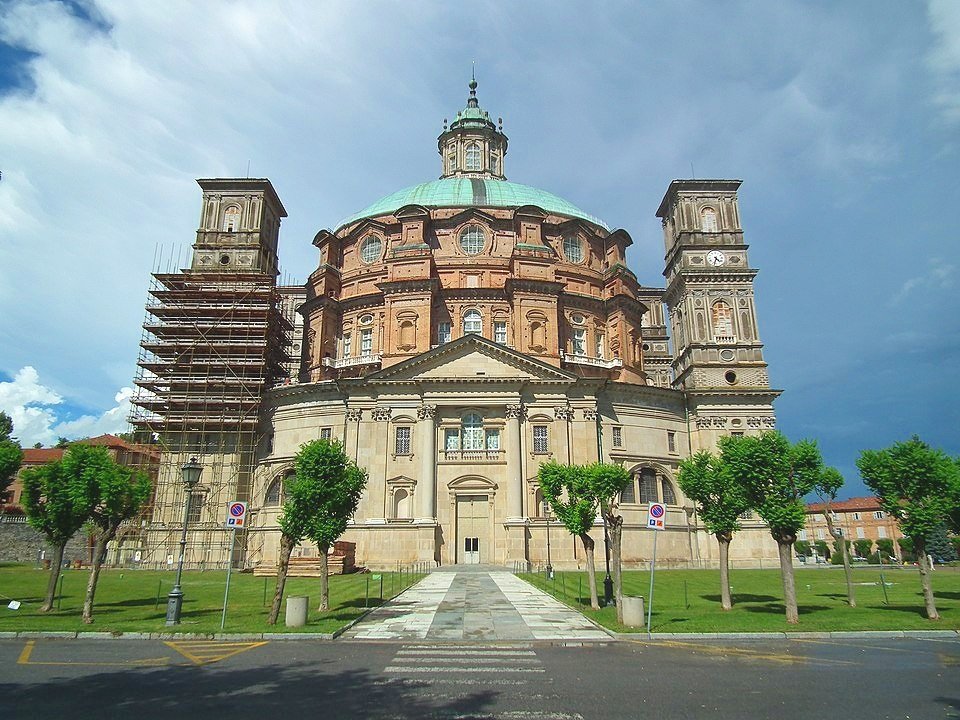The World’s Largest Elliptical Dome at Italy’s Sanctuary of Vicoforte
The Sanctuary of Vicoforte in Vicoforte Mondovì, Italy
Image | Mattis, Wikimedia Commons
Sometimes called “the king of all roofs,” domes cover some of the most important buildings in the world. Curved structures without angles or corners, they require no columns, and they maximize the space below. This expanse often houses something spectacular, like Lorenzo Bernini’s Baldacchino—the main altar in St. Peter’s Basilica that stands seven stories tall—or simply creates an elegant, open space in which many people can congregate. Despite their thinness, they are strong, stiff, and able to stand for centuries. Built in 126 AD, by the ancient Romans, the Pantheon is the oldest and largest unreinforced concrete dome in the world.
Italy is home to another dome—one that you have probably never heard but which holds a couple of records and is a marvel sight to see. Well off the beaten path, in the tiny town of Vicoforte Mondovì in the region of Piemonte, the Sanctuary of Vicoforte is the largest elliptical dome in the world. It boasts the largest, single themed frescoed surface, covering 64,930 square feet —try to put that in the context of your living room!
The frescoed vault by Mattia Bortoloni and Felice Biella, 1752
Image | Marco Plassio, Wikimedia Commons
Originating as a small medieval sanctuary, it housed a shrine containing a pillar depicting a Madonna and Child. A huntsman accidentally struck the image of the Virgin in 1590. According to legend, she began to bleed, and the hunter laid his arquebus (a long, matchlock gun) at the shrine and began to collect money to repair the damage. The arquebus is still on display in one of the sanctuary’s chapels.
As word of the miracle began to spread, it became a center of pilgrimage. One of its earliest visitors was Duke Carlo Emanuele I of the Savoy, who in 1596 commissioned his court architect, Ascanio Vitozzi, to create a large sanctuary, where he intended to be buried. Vitozzi died in 1615 while the sanctuary was only partially erected and domeless. The construction stopped and wasn’t resumed until the 1700s under the architect Francesco Gallo, who designed the monumental elliptical cupola that measures 118 x 82 feet. On the day the scaffolding was removed, Gallo had to do the job himself because no one believed it would stand on its own. He brought in his own family to help.
As is the case with many monumental buildings in the past, the sanctuary took centuries to build and decorate, and the process was not without hiccups. The sanctuary was built up to the base of the dome’s drum pedestal in 19 years, while the cupola was built in just four years between 1728-1732. The fresco vaults took only two years and were completed in 1752 by Mattia Bortoloni and Felice Biella. It wasn’t until 1884 that the bell towers were added.
One of the most remarkable things about the sanctuary is how we can visit it today in all its glory. If you suffer from claustrophobia or acrophobia, you might choose to enjoy it from ground level, but if you are willing to climb some steps and pass through skinny corridors , you can go all the way to the top to take in the views —inside and out—from 160 feet high.
The €15 visit is organized through Kalatà Tours and includes an English audioguide. You’re required to don a hard hat and harness to reach the summit. At one point, you have to straddle a beam and squeeze through a fairly small gap to reach the first inner balcony, which gives you an amazing view of the church below as you walk around the base of the vault. The harness is used to connect you to a steep and narrow stairwell that you ascend (and later, descend) while going through a slender inner passage. It’s not scary, but it is a smart safety precaution in case someone loses their footing.
Another extraordinary thing that Kalatà can organize is a tour for people who don’t have the use of their legs. This visit is not for the faint of heart and is expensive at nearly €900 as a lot of people need to be on-hand to make it work. There is a hoist at the very top of the cupola that can lift someone up from the floor to the top in less than 5 minutes. The visitor (only one at a time) is wired with an audio piece that allows a guide to talk with them as they are hoisted up.
Want to visit and learn more?
Kalatà’s website is only in Italian (although if you go to their website via a Google search, Google can translate it to English), but you can contact them by email: booking@kalata.it. Tours are available in English. Viaggio Nel Monte Regale also has lots of information for visiting the area. If you feel like practicing your Italian, RaiPlay has an episode of Generazione Bellezza that features the Sanctuary of Vicoforte. You must register with RAI to watch it and it is only in Italian but it’s worth watching the second half, so you’ll know what to expect. I bet it will put a smile on your face. In a country where accessibility is limited for anyone in a wheelchair, what they have done here is amazing and a fitting tribute to a structure that was built to commemorate a miracle.




